We may earn revenue from the products available on this page and participate in affiliate programs. Learn more ›
_
Best Overall
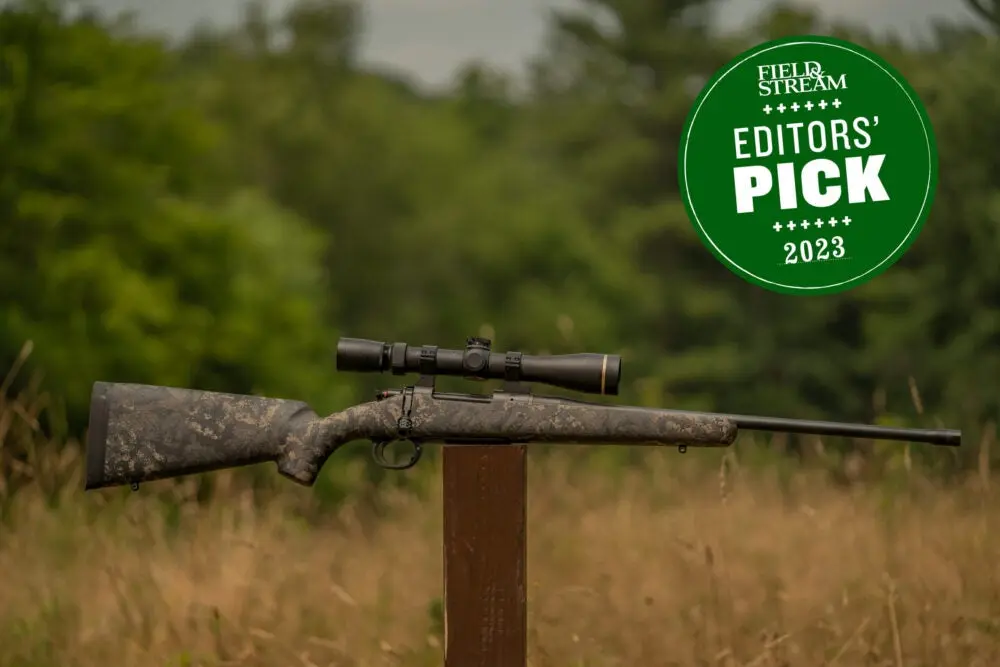
Wilson Combat NULA Model 20
Best Value
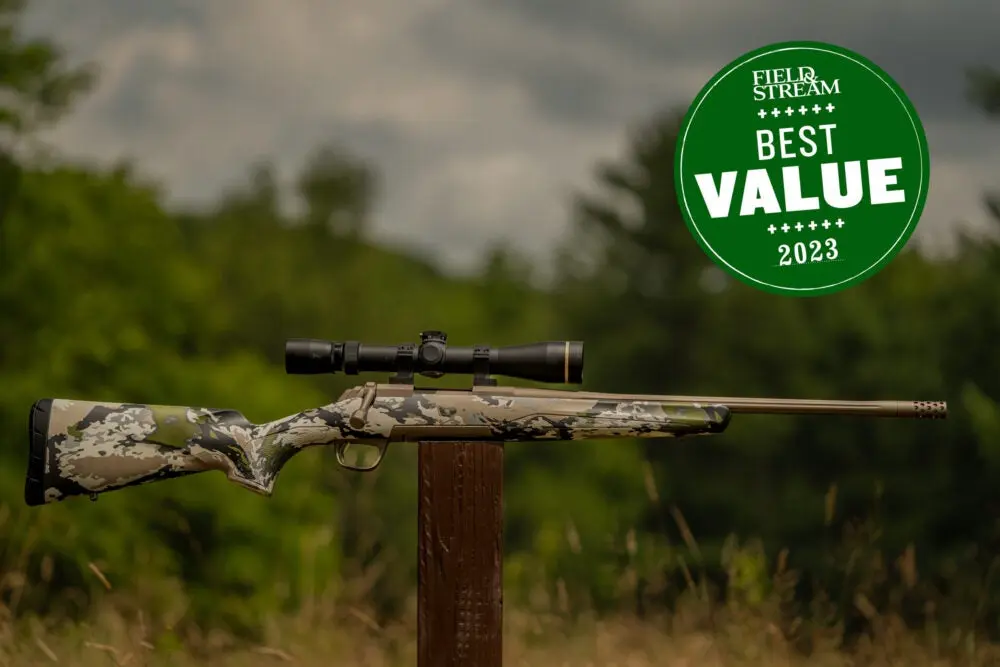
Browning X-Bolt Speed SPR OVIX
Coolest Rifle
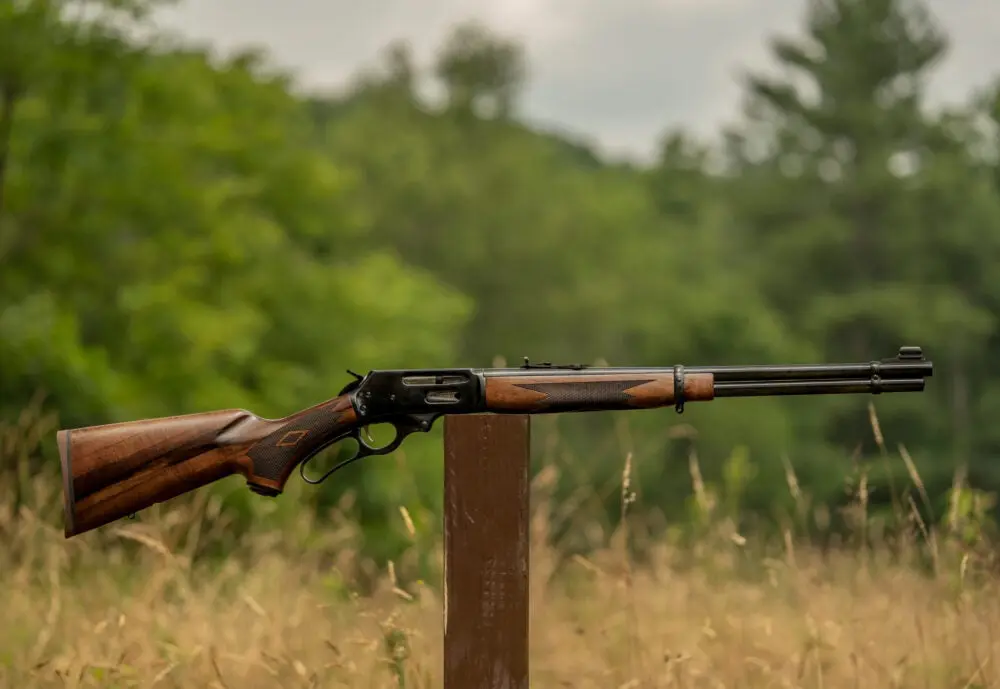
Marlin 336
The way we see it, if you’ve got space in your gun cabinet and some extra cash, it’s time to buy a new rifle. Or a new gun cabinet and then a new rifle. We can’t help you with the extra-cash part, but we did just spend weeks testing the best rifles to help you decide which new gun you should fill that empty space with.
Our crop of this year’s test rifles range in price from dirt cheap to damn and ouch! As a group, they’re suited for a wide range of hunting styles. And, building on a growing trend, they come in a dizzying array of shapes and forms. There was a time when hunting rifles looked like hunting rifles—and nothing like target rifles. But that’s all changed, and mostly for the better. First because you have more options now, and second because it means many of today’s hunting rifles take advantage of key innovations found on top target guns. If there’s a downside to this trend, it’s that it makes your job of deciding which new rifle to buy harder. But that’s what we’re here for.
Our testing team included F&S editor-at-large Matthew Every, F&S shooting editor, Richard Mann, and West Virginia game warden and former SWAT officer Will McGuire. We applied all that we’ve learned while shooting and hunting over the years to evaluate these 10 rifles, and we determined to test and score them fairly, and comment about them honestly, to help you decide which one you could trust this hunting season.
The Best Rifles
Best Overall: Wilson Combat NULA Model 20
Best Value: Browning X-Bolt Speed SPR OVIX
Coolest of the Test: Marlin 336 Classic
Best for Beginners: Savage Stevens Model 334
Most Versatile: Franchi Momentum All-Terrain Elite
Honorable Mentions
Best Overall: Wilson Combat NULA Model 20
Best Overall

Total Score: 96.03
Specs
Length: 39.38 inches
Weight: 5.17 pounds
Barrel: 20 inches, 1-in-8 twist
Action: Bolt, two-lug
Trigger: Timney Elite Hunter, adjustable
Capacity: 4+1
Finish: Armorlube DLC (action) Armor-Tuff (barrel) Hard Anodized (bottom metal)
Stock: AG Composites with Kodiak Rouge (tested), Canyon Rouge, or Charcoal grey finish
Chamberings: 243 Winchester, 6.5 Creedmoor (tested), 308 Winchester, 358 Winchester
Price: $3,295
Pros
Very precise shooting
Smooth action
Incredibly light
Perfectly balanced
Safety locks bolt
Cons
Expensive
Limited chamberings
Test Panel Notes
“The only reason not to buy this rifle is that your kids will probably fight over it after you’re gone.” —Matthew Every
“Far and above the best ultralight rifle available. If you’re a less-is-more kind of rifleman, you’ll not find more in a smaller/lighter package.” —Will McGuire
“Pound for pound, it’s probably the most accurate rifle currently manufactured.” —Richard Mann
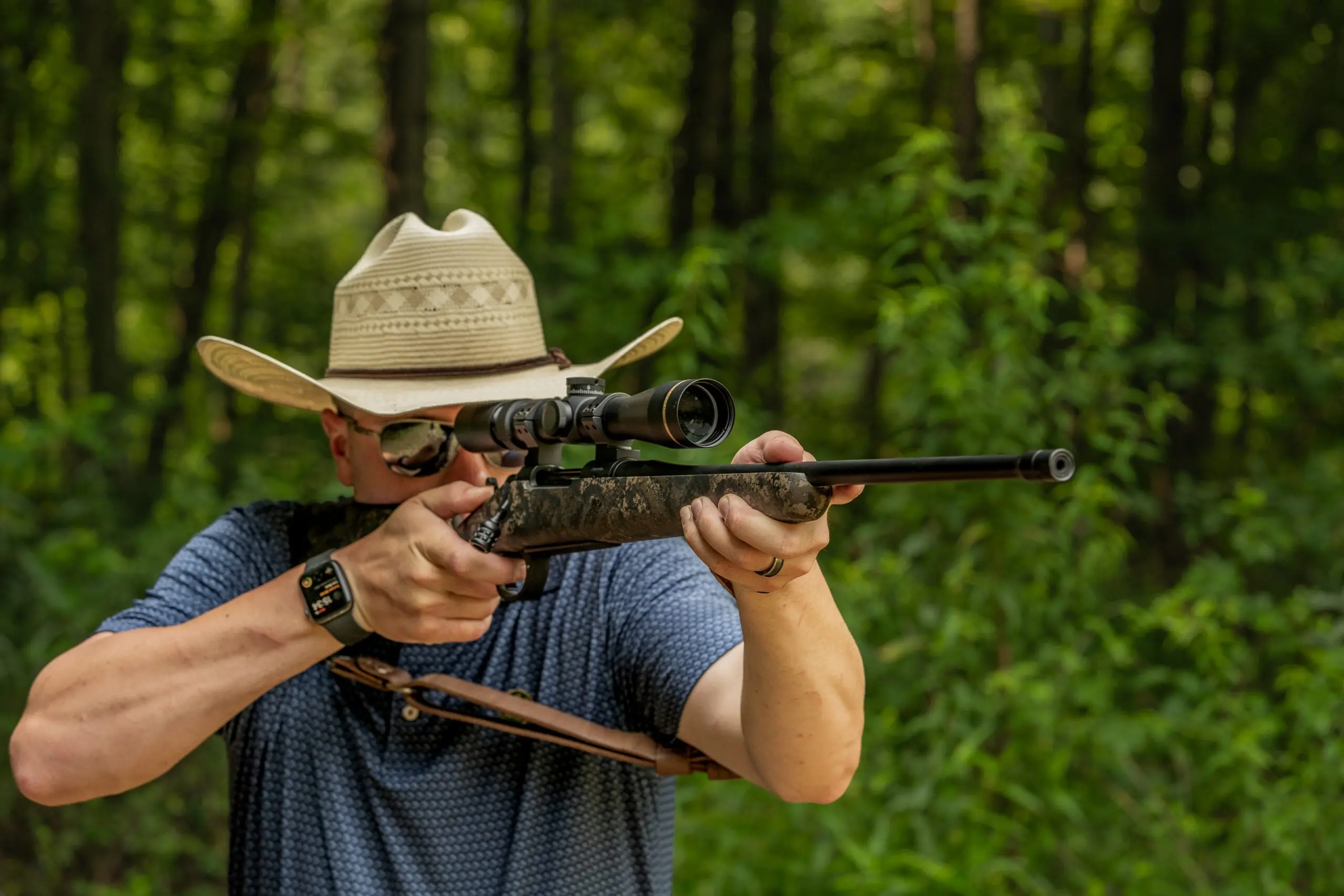
| McGuire shoots offhand with the NULA Model 20. Sabastian “Bat” Mann |
This rifle weighs 5 pounds, it’ll shoot through a donut hole at 100 yards, and it feels as lithe and nimble as a samurai’s katana. The cylindrical action is no larger than it has to be, and it’s supported in a carbon fiber AG Composites stock. The Wilson Combat button-rifled barrel is free-floated and threaded at 5/8×24, and it comes with a thread protector. An incredibly light-hinged floor plate is standard and provides easy unloading for the four rounds the magazine box contains. According to Wilson, each rifle is guaranteed to deliver sub-MOA precision and ships with a set of one-piece Talley scope rings that weigh 2 ounces.
The rifle is also fitted with an adjustable Timney Elite Hunter trigger that incorporates a two-position safety that locks the bolt handle down when in the “safe” position. The trigger broke as crisp as a cold winter morning, and the bolt lock keeps the bolt handle from getting snagged when walking through brush. Weightlessness is the hallmark of this rifle, but when you pick it up, you instantly feel the impeccable balance that allows you to handle it and shoot it from field positions accurately. Its best five-shot group was fired with Hornady 143-grain Precision Hunter ELD-X, and it measured 0.57-inch.
With the NULA Model 20, Wilson Combat is poised to continue the legacy of New Ultra Light Arms, and with a few tweaks like the threaded muzzle, oversized and grooved bolt handle, and the hinged floor plate, they’ve refined the design to better appeal to the modern rifle shooter. Evaluator Will McGuire gave this rifle his personal favorite point. I want one, too, but I want it in 308 or 358 Winchester… Decisions, decisions.
Best Value: Browning X-Bolt Speed SPR OVIX
Best Value

Total Score: 92.46
Specs
Length: 38.5 inches
Weight: 6.16 pounds
Barrel: 18 inches, 1-in-7 twist, threaded at 5/8×24, comes with brake and thread protector
Action: Bolt, three-lug, 60°
Trigger: Browning Feather Trigger, 3.2 pounds (as tested)
Capacity: 4+1, detachable magazine
Finish: Cerakote
Stock: Synthetic composite, with Browning Ovix Camo
Chambering: 204 Ruger, 223 Remington, 22-250 Remington, 6.5 Creedmoor (tested), 308 Winchester, 6.5 PRC, 6.8 Western, 7mm PRC, 7mm Remington Magnum, 28 Nosler, 300 Winchester Magnum, 300 PRC
Price: $1,429
Pros
Safety locks bolt
Comfortable to shoot
Very attractive
100% reliable
Lots of cartridges to choose from
Cons
Slightly butt heavy
Could have delivered more precision
Test Panel Notes
“I would feel just as confident hunting with this rifle in the woods as I would in open terrain where shots might be a bit longer.” —M.E.
“Short, light, and accurate. A pleasure to carry and very stylishly designed.” —W.M.
“Not too heavy, not too expensive, perfectly reliable, and accurate enough.” —R.M.
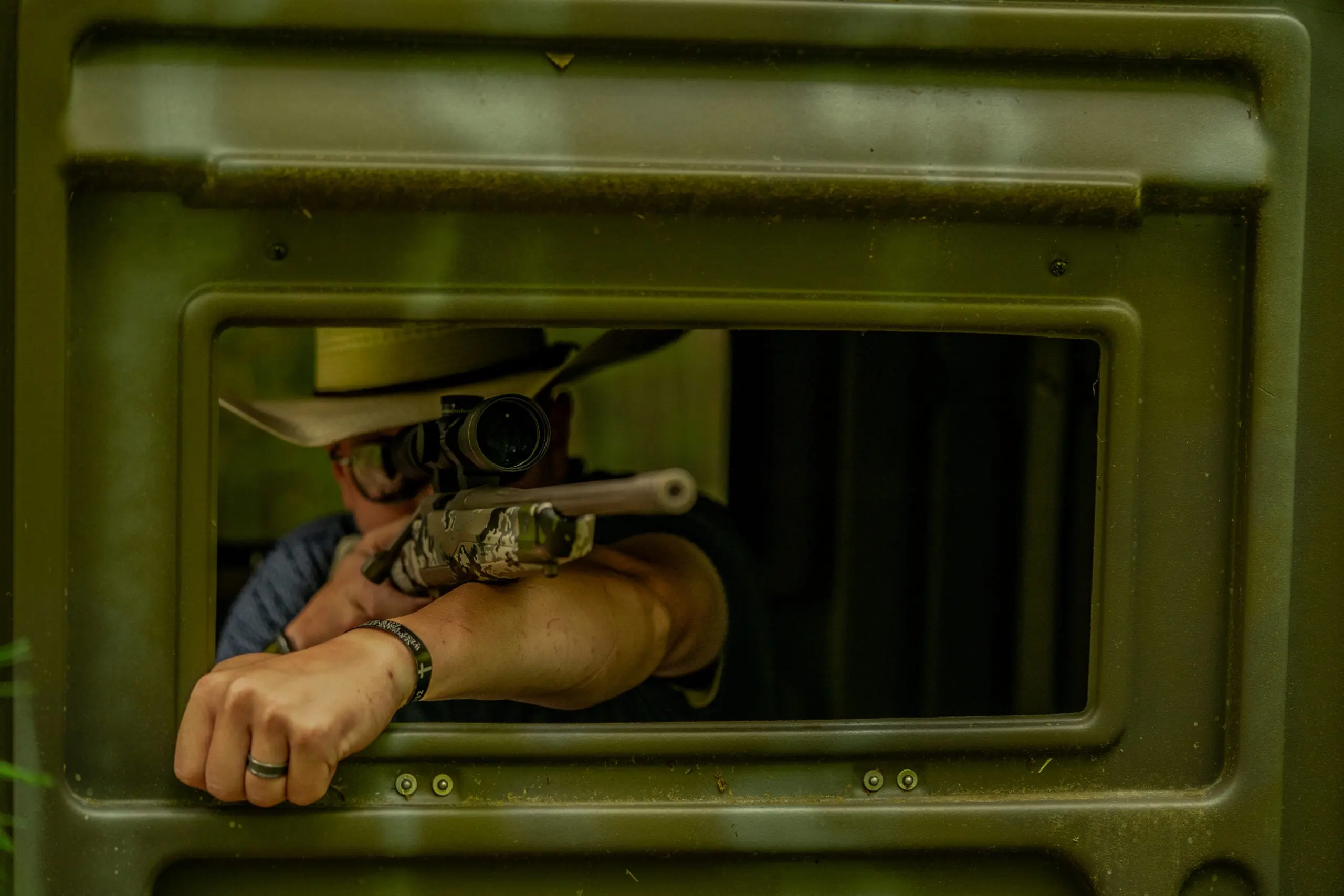
| McGuire fires the X-Bolt Speed SPR OVIX from a box blind. |
It might seem odd we’re awarding a $1,400 rifle the best value award, but there’s one thing you need to keep in mind. The best value does not mean “cheapest.” What it means is that you’re getting a hell of a lot of gun for the money you spend. What was wrong with this rifle? Not much really. Had it been fitted with a higher quality stock and shot a tad better, it would have given the Wilson Combat a run for the Best Overall award.
Operation of the 60°-throw bolt was flawless and smooth. The four-round detachable magazine fit flush in the stock, and it was easy to load, easy to insert, and easy to remove. It comes with an intuitive two-position tang safety that locks the bolt when in the “safe” position. (There’s a button on the bolt handle that unlocks it for loading or unloading on safe.) The stock was lean and trim with a cool-looking camo pattern and the trigger crisp, braking at 3.2 pounds. The rifle is drilled and tapped for scope bases but uses the peculiar, 4-screw, Browning pattern. For the test, we used Browning lightweight rings.
Overall, for the five loads we tested, the 100-yard group average for this rifle was 1.33 inches. That’s not great, but the Federal 135-grain Berger Hybrid Hunter load averaged 0.94 inches. All the evaluators liked the way this rifle felt and handled, and we all shot it well. It only weighs 6.1 pounds and is only 38.5 inches long, which makes it a dream to carry and not too long to work well inside a compact shoot house or blind. It does come with a radial port muzzle break that did a good job of lessening recoil, but the tradeoff is hellacious noise. We ditched the brake—it might be appreciated in some of the magnum chamberings, but in 6.5 Creedmoor it was pointless.
Coolest of the Test: Marlin 336 Classic
Coolest of the Test

Total Score: 91.10
Specs
Length: 38.5 inches
Weight: 7.21 pounds
Barrel: 20 inches, 1 in 12 twist
Action: Lever action
Trigger: 4.5 pounds w/ magazine
Capacity: 6+1
Finish: Polished blued steel
Stock: American black walnut
Chambering: (tested)
Price: $1,239
Pros
Excellent workmanship
Nice wood
Smooth action
Cons
Rudimentary sights
Test Panel Notes
“This is an heirloom-quality rifle that anyone in the family can shoot. The new 336 makes it easy to understand why hunters have used this for over 80 years.” —M.E.
“Just like the old 336, this new Marlin will continue to put meat on the pole well into the future.” —W.M.
“Refined and reintroduced, one of America’s greatest hunting rifles is proudly living on.” —R.M.
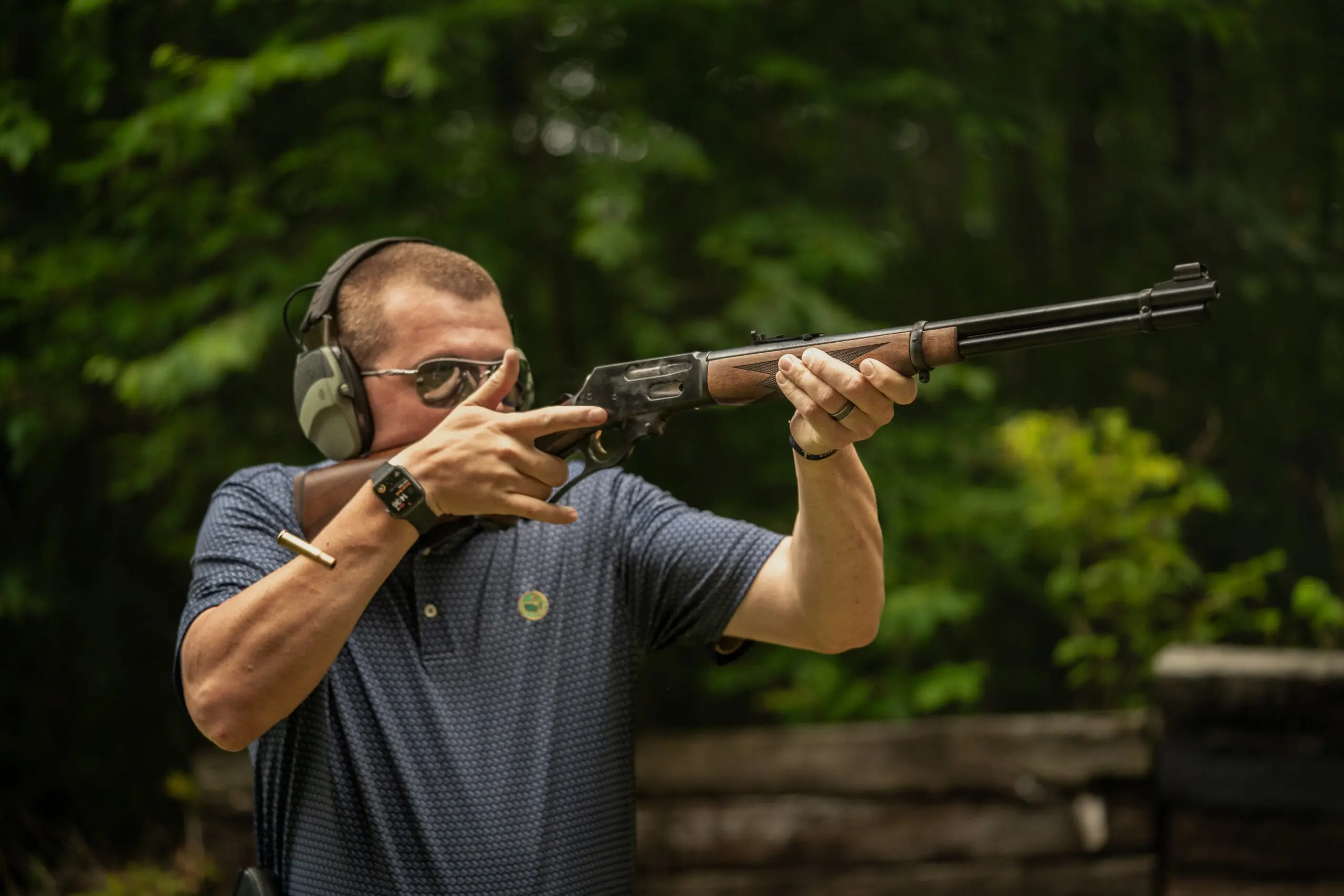
| Cycling the slick new Model 336 Classic on the range. |
When Remington went bankrupt in 2020, Marlin Firearms was caught in the collapse. Shortly after, Ruger purchased Marlin and reintroduced several 45-70 lever guns. But the Marlin Model 336 has always been the company’s flagship rifle, and the demand for its reintroduction was high. This year it’s finally back and available in America’s classic lever-gun chambering, the 30-30 Winchester. (Rumor has it, a 35 Remington and/or a 360 Buckhammer might be in the works.)
The craftsmanship used on this 336 is better than I’ve seen on Marlins under Remington’s ownership in 2013. Fit and finish were exceptional, the bluing superb, and the action was butter smooth. The rifle retains the cross-bolt safety that many do not like, but it unquestionably makes unloading the rifle safer. It’s also fitted with an adjustable buckhorn rear sight and a hooded brass bead front sight. These are the traditional sights for this rifle, but all of the testers would have preferred XS or Skinner aperture sights as at least an option. Regardless, we shot this rifle more than any other rifle in the test, mostly because it was the most fun to shoot. We used it to hammer the running deer target and to whack steel plates out to 100 yards.
This rifle shot its best five-shot group at 100 yards with Remington 150-grain Core-Lokt using the Leupold VX-3HD 4.5-14X40 CDS-ZL rifle scope. It measured 1.67 inches , and overall, the rifle averaged 2.24 inches for all groups fired. However, after the precision testing, we removed the scope and did all the other shooting with the factory open sights. Editor-at-large Mathew Every gave it his personal favorite point, partly because it was very attractive, partly because he enjoyed shooting it so much, but maybe mostly because he secretly wishes he was a cowboy. Regardless, if you like a 30-30 lever-action and want a new one, you can’t go wrong with the Marlin 336. In my opinion, it has always been and remains the best 30-30 lever-action rifle ever made.
Best for Beginners: Savage Stevens Model 334
Best for Beginners

Total Score: 87.75
Specs
Length: 41.25 inches
Weight: 7.24 pounds w/ magazine
Barrel: 20 inches
Action: Bolt, three-lug, 60°
Trigger: 5.75-pounds (as tested)
Finish: Matte blue
Stock: Turkish walnut (Synthetic stock optional $389.00)
Chambering: 243 Winchester, 6.5 Creedmoor, 308 Winchester (tested)
Price: $489
Pros
Attractive stock
Smooth action
60° bolt throw
Cons
A bit clunky in look and feel
Limited capacity
Test Panel Notes
“This is an straightforward rifle that any new deer hunter could have success with.” —M.E.
“With this rifle, you probably won’t be the talk of deer camp—until you come in with your buck.” —W.M.
“You might not brag about this rifle, but you can trust it, and it’s flying under the inflation radar.” —R.M.
The Savage Stevens Model 334 Walnut is not the best bolt-action rifle ever made. But it is an ideal entry-level rifle for the new hunter. It’ll give them the traditional feel of a walnut stock and blued steel, it’ll deliver enough precision for shooting at distances a new hunter should not exceed, and it works. It works every time you pull the trigger and every time you cycle the bolt. It’s also affordable enough to allow for the purchase of a dependable riflescope and for enough ammunition for a new hunter to develop their shooting skills.
The Savage Stevens Model 334 is made in Turkey, and the action, with its 60° bolt throw, has an integral recoil lug. It’s fitted with a 20-inch, button-rifled, carbon-steel barrel with an 11° target crown. The action is drilled and tapped for scope bases on the Savage M110 footprint, and it comes with a steel MIL-STD 1913 Picatinny rail already installed. It has a polymer, three-round detachable magazine that was easy to load, insert, and remove, and it functioned flawlessly throughout the test. One of the features we really liked was the three-position slide-switch style safety that locked the bolt in the “safe” position. This is a commonsense feature missing from many bolt-action hunting rifles costing 10 times as much or more.
We tested the Stevens Model 334 with four loads, and while it was not a tack driver—with one group even spreading to 2.48 inches—its overall average was less than two inches. Its best group, fired with the Browning Long Range load, measured less than an inch. This is not a long-range rifle by any stretch, but it has plenty of precision to handle most of the shots on big game that most hunters should be attempting. The checkering was crisp, the rifle felt comfortable on the shoulder, and it never failed to function.
Most Versatile: Franchi Momentum All-Terrain Elite
Most Versatile

Total Score: 88.83
Specs
Length: 40.0 inches
Weight: 7.3 pounds w/ magazine
Barrel: 18-inch, 1 in 11 twist
Action: Bolt, three-lug, 60°
Trigger: Relia Trigger, adjustable, single stage
Capacity: 10+1, detachable AISC magazine
Finish: Midnight Bronze Cerakote (action & barrel) Chrome (bolt)
Stock: Synthetic TrueTimber Strata
Chambering: 223 Remington, 308 Winchester (tested) 5.56 and 7.62 NATO compatible
Price: $1,449
Pros
Back up open sights
Versatile optics rail
Multiple sling attachment points
M-Lok compatible
Cons
Only available in 223 Remington and 308 Winchester
Heavy
Test Panel Notes
“If you could only buy one bolt-action rifle for all of your needs, this one is hard to beat.” —M.E.
“Very well configured for general-purpose shooting.” —R.M.
Franchi advertises this as an “All Terrain” rifle. I’m not really sure what that means, but they also say it’s for everyday use, and I think that comes closer to describing its intended use. It’s loaded with features that most typical hunting rifles do not have. These include backup sights, six QD swivel attachment points, three M-Lok rails in the forend, a stepped belly of the stock for sandbag/hand support, and a 10-round detachable magazine. There are also accessories available for purchase from Franchi like recoil pads of various thicknesses, replaceable stock combs in three heights, and a standard Picatinny scope rail.
The rifle is also fitted with a longer-than-normal optics rail that gives you options for mounting a traditional riflescope, a scout scope, or a red dot sight. Additionally, it has two sets of back-up open sights. The first are fold-up sights that include an aperture rear that’s adjustable for windage and an AR-style front sight that’s adjustable for elevation. These were adjusted dead on at 50 yards right out of the box. If you fold these sights down, there’s a notch rear sight and a small blade front sight that are integral. They might be considered as some sort of battlesight, but they’re not independently adjustable and placed the bullet about five inches low at 25 yards.
The rifle functioned exquisitely, and the overall average for the four loads we tested at 100 yards was 1.47 inches. Its best group was fired with Browning’s 165-grain Long Range load and measured 0.895-inch. The rifle’s stock seems a bit chunky and had a rattle, and the survivability of what appeared to be a dipped camo finish is questionable. However, if you want one rifle for hunting big game, feral hog eradication, predator calling, and maybe for defending your home from the zombie hoards, this is the gun. I did not want to like it but couldn’t help but respect its versatility, so I gave it my personal favorite point.
Bergara B14 Squared Crest
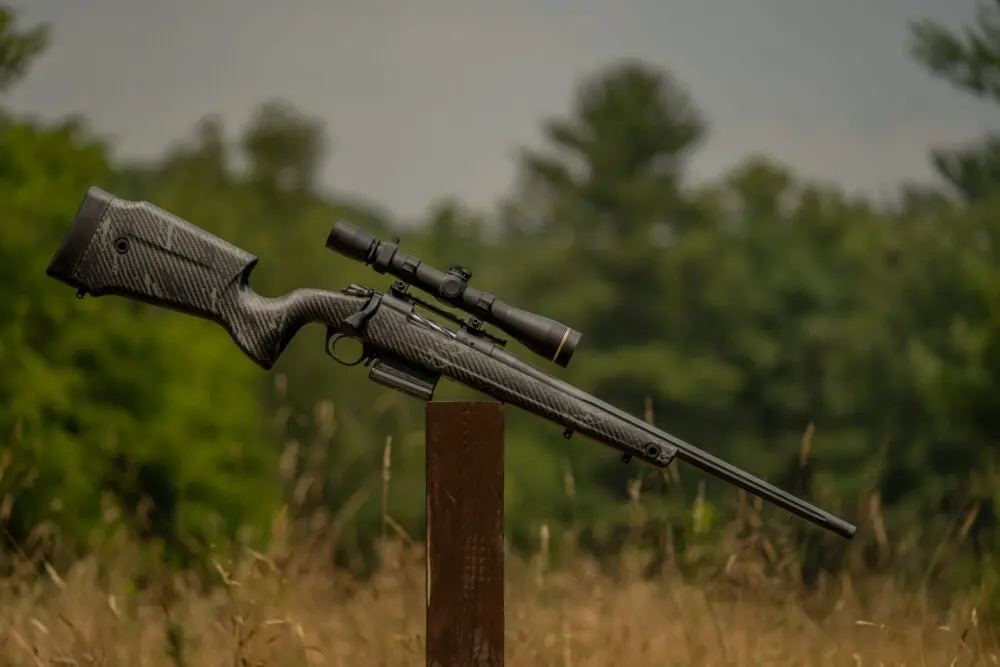
Total Score: 90.85
Specs
Length: 41.25 to 42.02 inches
Weight: 7.34 pounds, w/ magazine
Barrel: 20 inches, fluted, 1 in 8 twist, with muzzle brake and thread protector
Action: Bolt, two-lug
Trigger: 2.0 pounds (as tested)
Capacity: 5+1
Finish: Cerakote sniper grey
Stock: Carbon fiber with a carbon spine
Chambering: 6.5 Creedmoor (tested), 6.5 PRC, 308 Winchester, 300 Winchester Magnum
Price: $1,999
Pros
Smooth action
Precise shooter
Cons
Safety doesn’t lock bolt
Missing an adjustable comb and rail interface for bipod or tripod attachment
Test Panel Notes
“The carbon-fiber-stocked, target-style hunting rifle is becoming somewhat of a standard, and Bergara’s version is solid.” —M.E.
“Short, light, accurate, and stylish. A great trigger and a smooth action.” —W.M.
“A good shooting, mid-weight Bergara B14 that hunters with long-range aspirations can appreciate.” —R.M.
If you’ll notice, there were less than three points separating the second and eighth-place rifles in this test. Figuratively, we were splitting hairs. It was hard to find anything wrong with the Bergara Squared Crest rifle, it’s best five-shot group was less than an inch and was fired with the Hornady 143-grain Precision Hunter load. Overall, the rifle averaged 1.21 inches for all groups fired and two of the four loads averaged less than an inch. The rifle also functioned without fail_,_ and it has a new stock configuration that includes a carbon-fiber spine that substantially improves rigidity and toughness.
All the rifles in Bergara’s B14 series are well respected. The Squared Crest is built in the style of rifle that many new-millennium hunters are drawn to. With a stock similar to what’s found on sniper/long-range competition rifles and its detachable AICS magazine, it’s suitable for matches like NRL Hunter. However, its thinner barrel and lighter weight make it appealing to hunters who want to hike in deep and extend their reach.
The Squared Crest sort of bridges the gap between Bergara’s traditional hunting Ridge and Hunter B14 rifles and their B14 HMR, which is configured more for competition. It comes with an adjustable length of pull, but we felt that priced at $800 more than the B14 HMR, it should have included an adjustable comb as well. This would have greatly improved the shooter interface. We did appreciate the four quick detach sling swivel points but felt a short rail section would be better than the traditional dual sling swivel studs on the forend. The rifle is also advertised at 6.9 pounds but our test sample in 6.5 Creedmoor weighed 7.34 pounds.
Stag Arms Stag 15 Pursuit
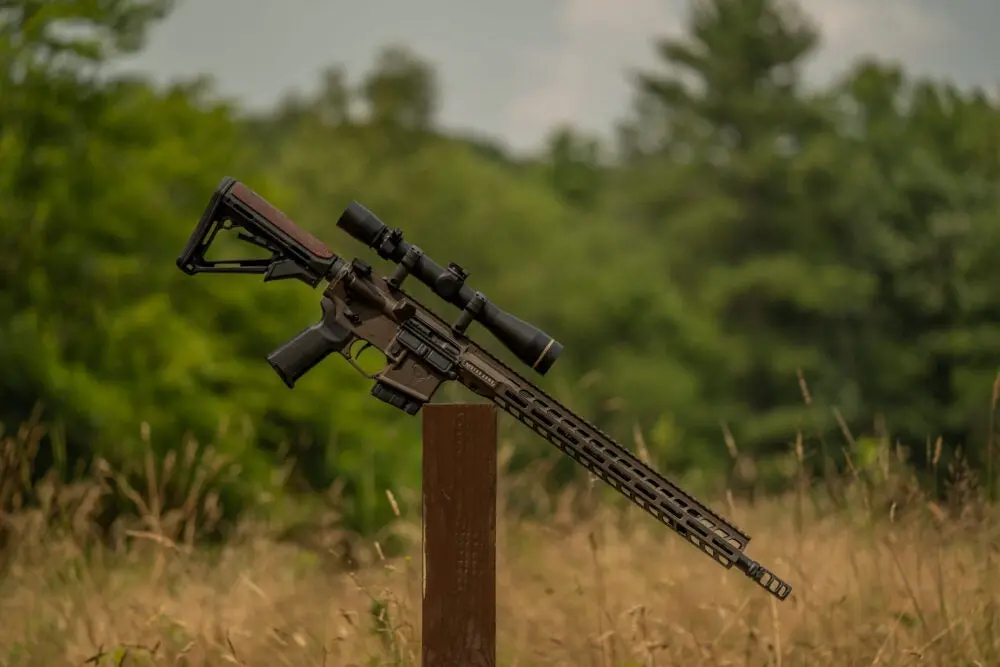
Total Score: 90.76
Specs
Length: 35.0 to 38.5 inches
Weight: 7.48 pounds w/ magazine
Barrel: 18 inches, 1-in-8 twist, threaded 5/8×24, with VG6 Gamma Brake
Action: Semi-auto, gas impingement, (rifle length)
Trigger: Timney Two-Stage Trigger
Capacity: 5+1 detachable magazine
Finish: Cerakote midnight bronze
Stock: Magpul CTR Stock w/ leather check rest
Chambering: 6.5 Grendel (tested), 350 Legend
Price: $1,599
Pros
Available in left or right hand
Great trigger
Leather-wrapped comb
Length of pull adjustable on the fly
Cons
Full-length handguard adds unneeded weight
Muzzle brake difficult to remove
Test Panel Notes
“The Pursuit is not just an AR painted in a hunting color. It has the kinds of features AR shooters like, configured in a way hunters will appreciate too.” —M.E.
“Sized right and reliable, this is an AR15 for any hunter, whether they’re left- or right-handed.” —R.M.
Some hunters just can’t warm to the AR15. Not because it’s a political football, or because it’s a semi-automatic, but mostly because its tactical appearance and feel is off-putting to the traditionalist. The new Pursuit line of ARs from Stag might change your mind. They come in a neutral midnight bronze color, the adjustable Magpul stock has a leather-wrapped comb, and the Stag 15 version is chambered for hunting cartridges like the 6.5 Grendel and 350 Legend. Rifles in the Pursuit series also come standard with a Timney two-stage trigger. The one on our test rifle broke icicle crisp at 3.5 pounds.
The AR15 platform was designed for right-handed shooters, but Stag Arms offers all their Pursuit rifles in a right or left-hand configuration. And, the left-handed rifles are mirror images of the right-hand versions—not just built to eject to the left side. The charging handle is also ambidextrous, which simplifies loading and unloading. And the rifles are outfitted with a 16.5-inch M-Lok compatible handguard that had an integral top rail with 42 slots. This allows you to outfit a Pursuit with any optical and/or open-sight configuration you like, including night vision adapters.
We only had two 6.5 Grendel loads to test in the Stag Pursuit. The best group fired was with the Barnes 115-grain TAC X BT load and it measured 1.32 inches. Overall, for all the five-shot groups fired, the rifle averaged 1.66 inches, which is about average for most across-the-counter AR15-style rifles. This rifle was put together well and gave the impression of quality. It also functioned flawlessly. Hammering six accurate hits into the running deer target was as easy as poking a finger in your buddy’s eye when he asks you why you’re hunting with an AR15. Stag Arms also offers a Stag 10 version of the Pursuit which is available in 6.5 Creedmoor or 308 Winchester.
Nosler Model 21 Carbon Chassis Hunter
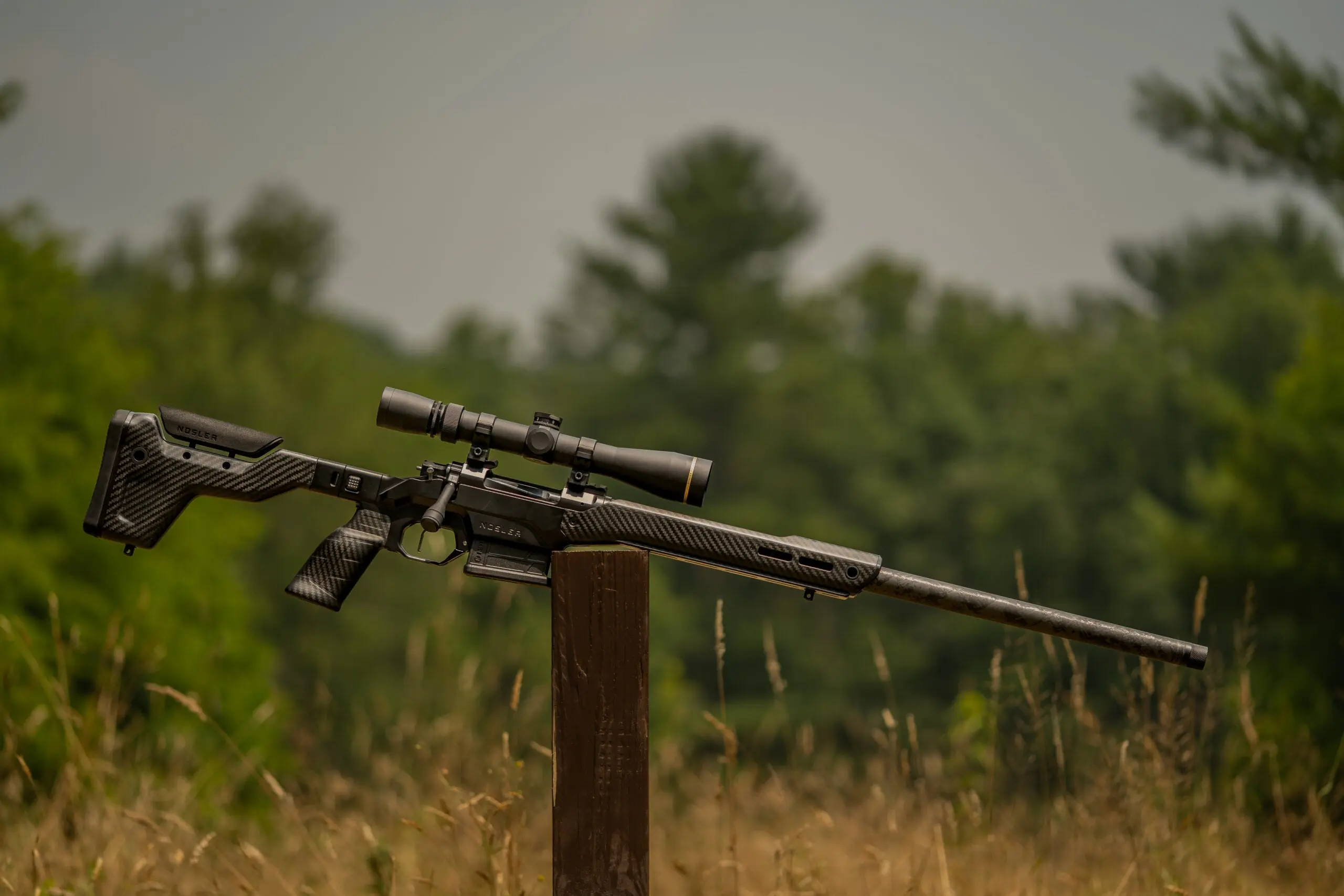
Total Score: 90.70
Specs
Length: 43.0 inches
Weight: 6.55 pounds
Barrel: 24 inches,
Action: Bolt, two-lug
Trigger: Trigger Tech Primary Trigger (2.0 pounds as tested)
Capacity: 5+1 (4+1 in 6.5 PRC)
Finish: Cerakote
Stock: Magnesium chassis, with carbon fiber handguard and collapsible carbon fiber butt stock.
Chambering: 6.5 Creedmoor (tested), 6.5 PRC, 28 Nosler, 300 Winchester Magnum
Price: $5,395
Pros
Lightweight
Long barrel for maximum velocity
Extreme precision
Cons
Expensive as hell
Not ideally suited for snap shooting
Test Panel Notes
“This rifle is put together like a Swiss watch. Sure, it’s expensive, but you get what you pay for, and Nosler has delivered.” —M.E.
“If you have a once-in-a-lifetime tag to fill and a tough shot, this is the rifle for the job.” —W.M.
“Too expensive for your average hillbilly like me, but accurate enough for anyone.” —R.M.
Previously, Nosler’s Model 21 rifle was selected as the Editor’s Pick of the Field & Stream rifle test. It didn’t achieve that distinction this time around, partly because it is so frigging expensive, but also partly because it is more of a niche rifle for backcountry hunters who want to take long shots. But that does not mean this is not a great rifle, because it is, especially if that’s your idea of hunting.
Built around the excellent Model 21 action, the Nosler Carbon Chassis hunter is available chambered for four proven big-game cartridges and is fitted with either a 24- or 26-inch carbon-fiber-wrapped barrel to extract all the velocity they have to offer. The barreled action rests in a V-block chassis, which is fitted with an ultra-light carbon fiber forend that has an integral ARCA rail, and a folding carbon fiber butt stock that can be adjusted for length of pull. The chassis also has a carbon fiber pistol grip, which while very comfortable for precision engagements, is not ideally suited for snap shooting or quick shots from the off-hand position. This rifle is best at home on a bipod or thrown over a backpack, when you need to reach across a canyon to whack a big mule deer buck.
We tested three loads in this rifle. The Federal Fusion load delivered the best group of 0.53-inch and averaged only 0.64-inch for all groups fired. The Hornady ELD-X Precision Hunter load also averaged less than an inch. However, the rifle did not like the 120-grain Barnes TTSX load, and this opened the overall average up to 1.02 inches. The trigger was excellent, the rifle was easy to carry in hand, and to carry by sling because of the four QD swivel attachment points. We gave it excellent marks in every category except price. If a lightweight, tack-driving, backcountry rifle is what you want, you’ll be hard-pressed to find something better. But neither your wallet nor your spouse will like you very much when you come home with it. The critters you’re shooting at won’t like it either.
Marlin 1894 Classic
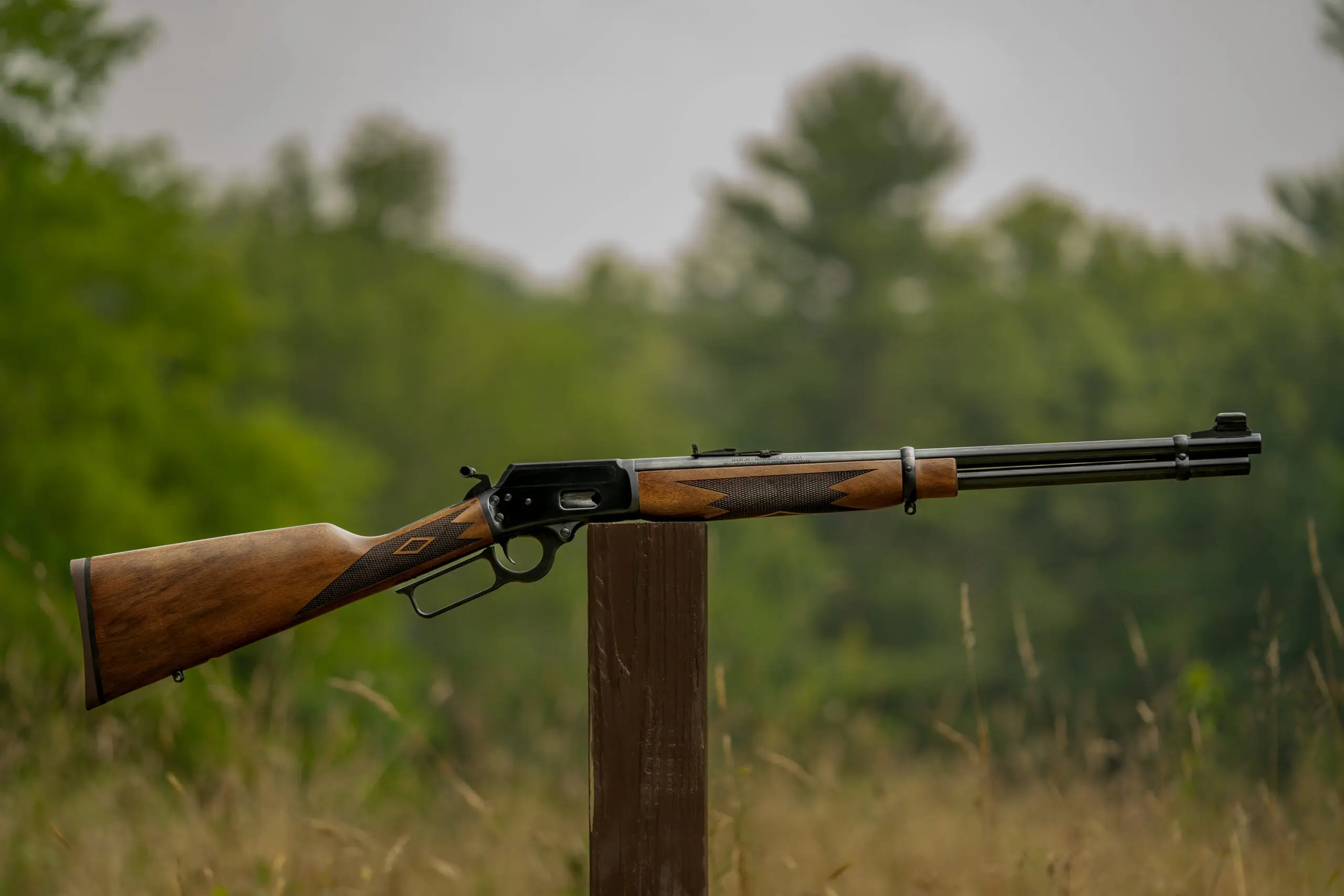
Total Score: 89.93
Specs
Length: 37.75 inches
Weight: 6.29 pounds
Barrel: 20.25 inches, cold hammer forged alloy steel w/ 1-in-20 twist,
Action: Lever
Trigger: 4.0 to 4.75 pounds (as tested)
Finish: Satin blue
Stock: American black walnut
Chambering: 44 Remington Magnum
Price: $1,239
Pros
Excellent fit and finish
Easy to load
Trim forend
Nicely balanced
Cons
Inconsistent trigger
Rudimentary sights
Test Panel Notes
“Ruger/Marlin could have cut corners to make this rifle a little cheaper, but they didn’t. If I was in the market for a revolver-cartridge lever-gun, I wouldn’t look anywhere else.” —M.E.
“When things get western in the woods, I can think of no better medicine than a fast shooting lever gun like this one in 44 Magnum.” —W.M.
“As a hunter, protector, or both, this rifle will allow you to express your inner cowboy. —R.M.
Since just before the beginning of the 20th Century, the lever-action rifle has been America’s rifle. This paradigm began to shift at the beginning of the 21st Century as the AR15 pushed the lever gun to the side and assumed that title. But the lever-action rifle has not died or passed into obsolescence, partly because it is still a viable and dependable general-purpose rifle—and partly because everyone has a little cowboy in them. The Marlin 1894, with its compatibility with revolver cartridges, has always made it a favorite. With its reintroduction, Marlin has made a lot of shooters happy.
This rifle is well put together. The wood-to-metal fit is very well executed, and the metal finish and bluing take you back to a time before plastic stocks and heartless chemical coatings existed. The butt stock on the 1894 has a straight grip and it is capped off with a thin, brown recoil pad. The pad is probably not necessary, but unlike the old plastic butt plates Marlin used, it keeps the rifle from sliding across the floor when you lean it in the corner behind the door. The action was very smooth. It cycled and fired 44 Special ammunition perfectly, but we did experience some sticky extraction with the hottest 44 Magnum loads. The receiver is drilled and tapped for scope mounts and is compatible with aftermarket XS or Skinner-style aperture sights.
From the bench, the 1894 was not a tack driver. But 44 Magnum lever guns never have been. With the five loads tested, it averaged 3.17 inches, and with a riflescope attached, its best groups were right at 2.5 inches with the now discontinued 240-grain load from Sig Sauer and the relatively new 270-grain Federal HammerDown load. The trigger pull was crisp but a bit inconsistent; it varied in pull weight from 4.0 to 4.75 pounds. However, for snap-shooting deer, this rifle will excel. On our running deer target, it was as deadly as a double shot of Jägermeister. Those who hunt deer in the timber, feral hogs over bait, want a compact rifle for trailing bear hounds, or a rifle for bear defense will be more than pleased with the 1894 Marlin.
Savage Arms Impulse Mountain Hunter
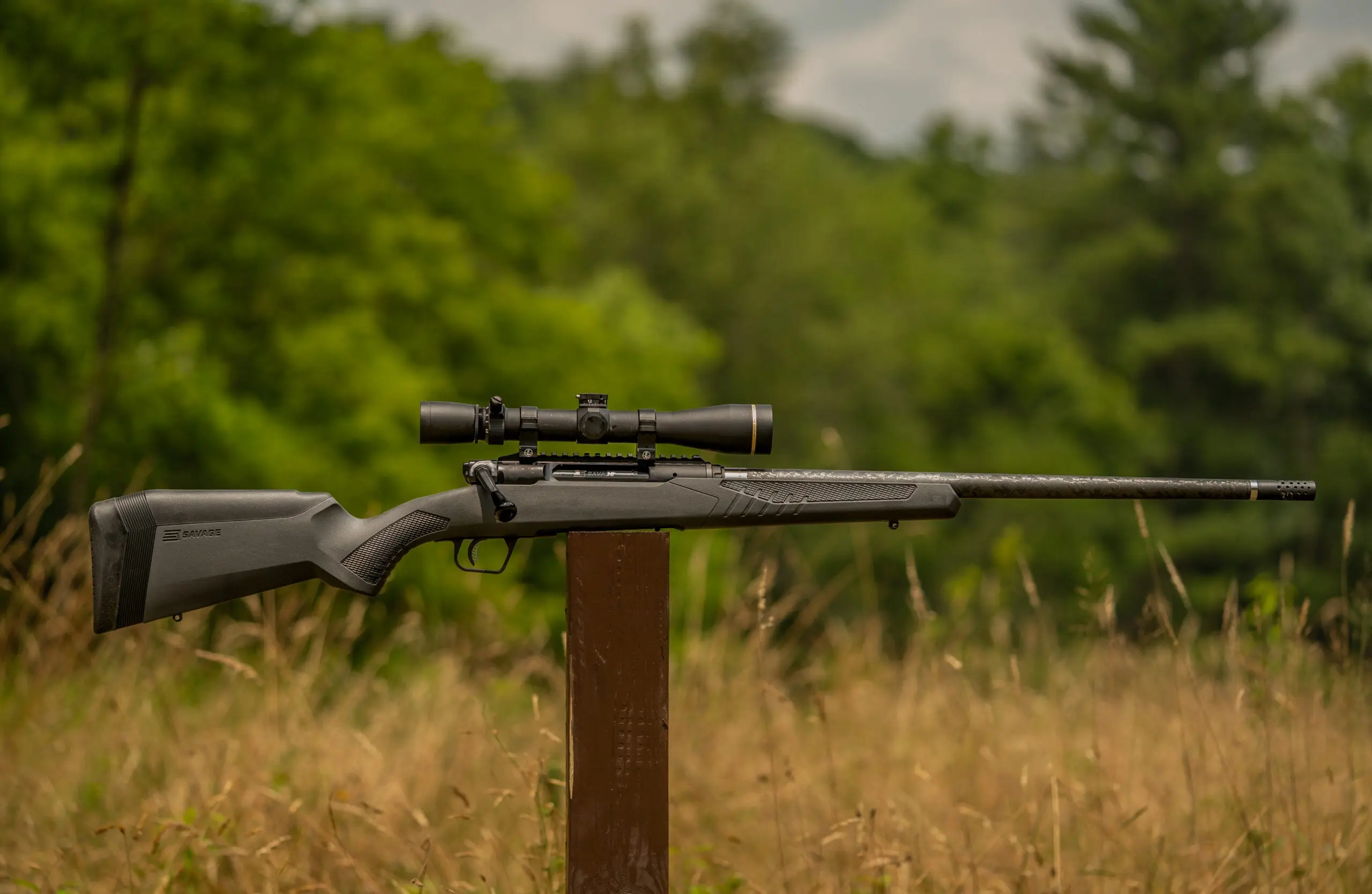
Total Score: 79.90
Specs
Length: 44.75 inches (adjustable)
Weight: 7.19 pounds
Barrel: 22 inches, Proof Research carbon fiber wrapped stainless steel, threaded at 5/8×24, muzzle brake and thread protector, w/ 1-in-10 twist
Action: Impulse, straight pull, ball bearing lock-up
Trigger: AccuTrigger, (3.25 pounds as tested)
Capacity: 4+1, Detachable magazine
Finish: Anodized black
Stock: Synthetic AccuStock
Chambering: 6.5 Creedmoor, 6.5 PRC, 270 Winchester, 7mm Remington Magnum, 7mm PRC, 28 Nosler, 308 Winchester (tested), 300 Winchester Magnum, 300 Winchester Short Magnum
Price: $2,437
Pros
Very precise shooting
Lightest Impulse yet
20 MOA scope rail integral to the action
Cons
Inconsistent/unreliable action operation
Extremely difficult to remove the muzzle brake
Test Panel Notes
“While I am not a fan of this action, this version of the Impulse is the best I’ve seen. Previous versions were too heavy, in my opinion, but this one carries lighter and is very accurate.” —M.E.
“It’s nickel-splitting accurate, but Savage needs to refine this action or forget it.” R.M.
This is the second year we’ve included a Savage Impulse in our rifle test, and just like last year we were somewhat underwhelmed. But the rifle does has some very good qualities, so let’s start there. Out of the box, the Impulse Mountain Hunter comes with Savage’s great user-adjustable AccuTrigger and their AccuStock, which is also user adjustable in length-of-pull and comb height. Both contribute greatly to shooter interface. The carbon-fiber-wrapped stainless steel barrel from Proof Research is also a nice touch. The rifle shot great and averaged 1.08 inches with the four loads tested. Its best five-shot group, which was fired with the 165-grain Browning Long Range load, measured only 0.607-inch. One of the rifle’s nicest features is that the bolt handle can be moved to the left side, which means the rifle is ambidextrous.
Now for the not-so-good. We had to heat the muzzle brake and use a pipe wrench to get it off the barrel so we could run a suppressor. More important, we had issues with action operation when we stepped away from the bench and began running it like a hunter would. Sometimes it would not open, especially when it got hot. Sometimes it would not fully close, particularly during fast cycling. But when it worked it was fast. On the moving deer target, we could get four shots off. (Interestingly, we did the same with two other standard bolt action rifles.) Maybe there’s a learning curve associated with this rifle. There shouldn’t be, and if there is we missed the memo. Also, it’s advertised as a “mountain” rifle, so you’d expect it to weigh less. All of that said, it’s a unique rifle that’s based on a proven concept, but it needs refinement.
How We Tested Rifles

| F&S editor-at-large Matt Every test fires the new Nosler Model 21 Carbon Chassis Hunter from prone. Sabastian “Bat” Mann |
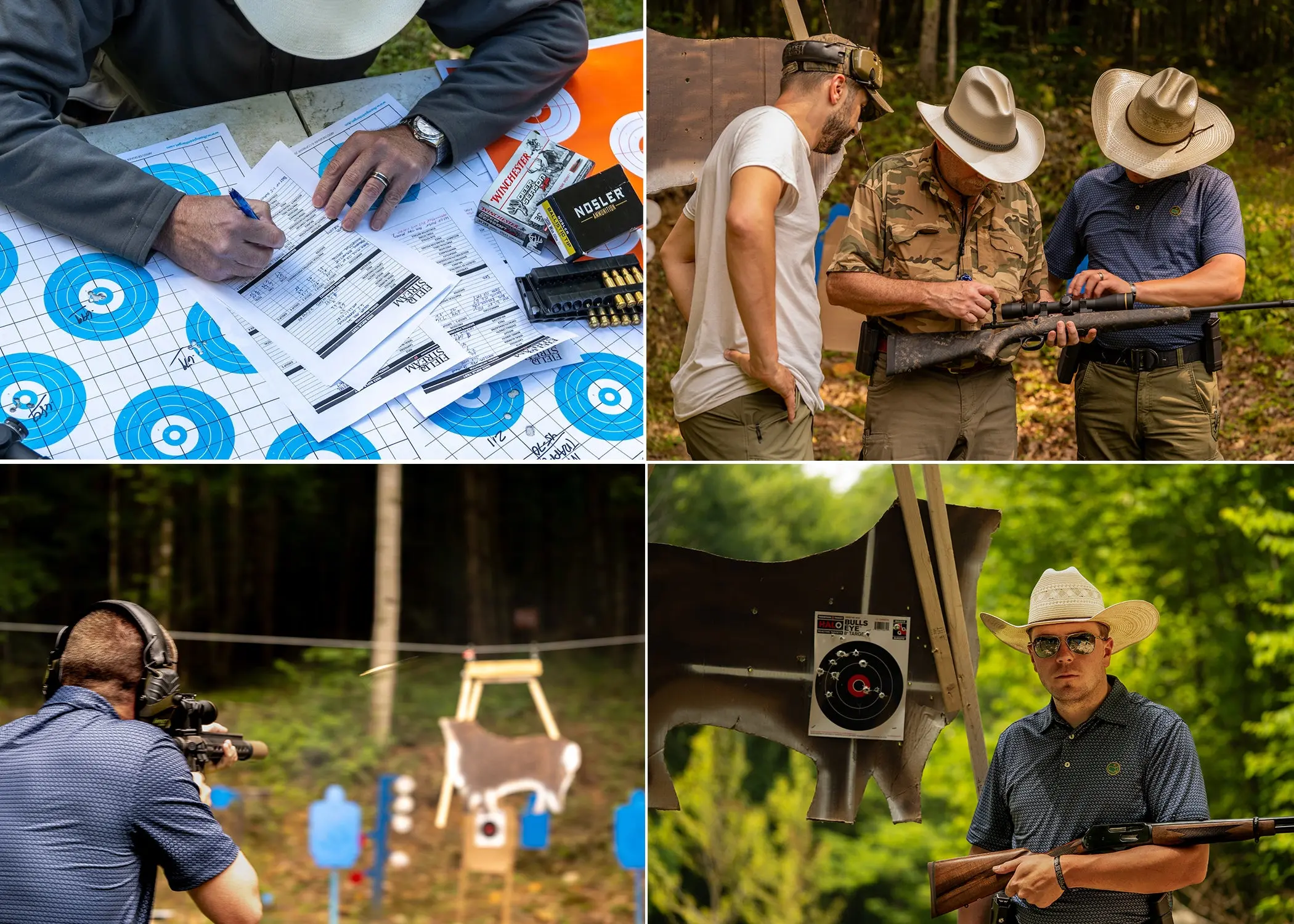
| Clockwise from top left: F&S shooting editor Richard Mann records group sizes; our test panel evaluates the Wilson Combat NULA Model 20; McGuire takes his turn at the running-deer target, which has an 8-inch Thompson Target hidden on the back side; 10 shots in the black with the new Marlin 336 Classic. |
The first thing we did when each rifle arrived was give it a once-over to familiarize ourselves with its features and controls. Then we mounted a Leupold VX-3HD 4.5-14X40 CDS-ZL scope, sighted the rifle in, and tested for precision by shooting from a bench. We fired multiple five-shot groups at 100 yards with a variety of ammunition, chronographing every shot fired. Next, each evaluator evaluated the rifle by shooting drills pertinent to how the gun would likely be used. These drills included rapid fire; shooting from field positions, tree stands, and box blinds; working with a sling while carrying and shooting; and shooting at a moving deer target. Much of the shooting with the rifles that had threaded muzzles was done with a suppressor. Once satisfied a rifle has been thoroughly scrutinized, we discussed its flaws and merits and then individually scored each rifle in secret. Finally, we totaled the scores and awarded the winners.
Scoring and Analysis
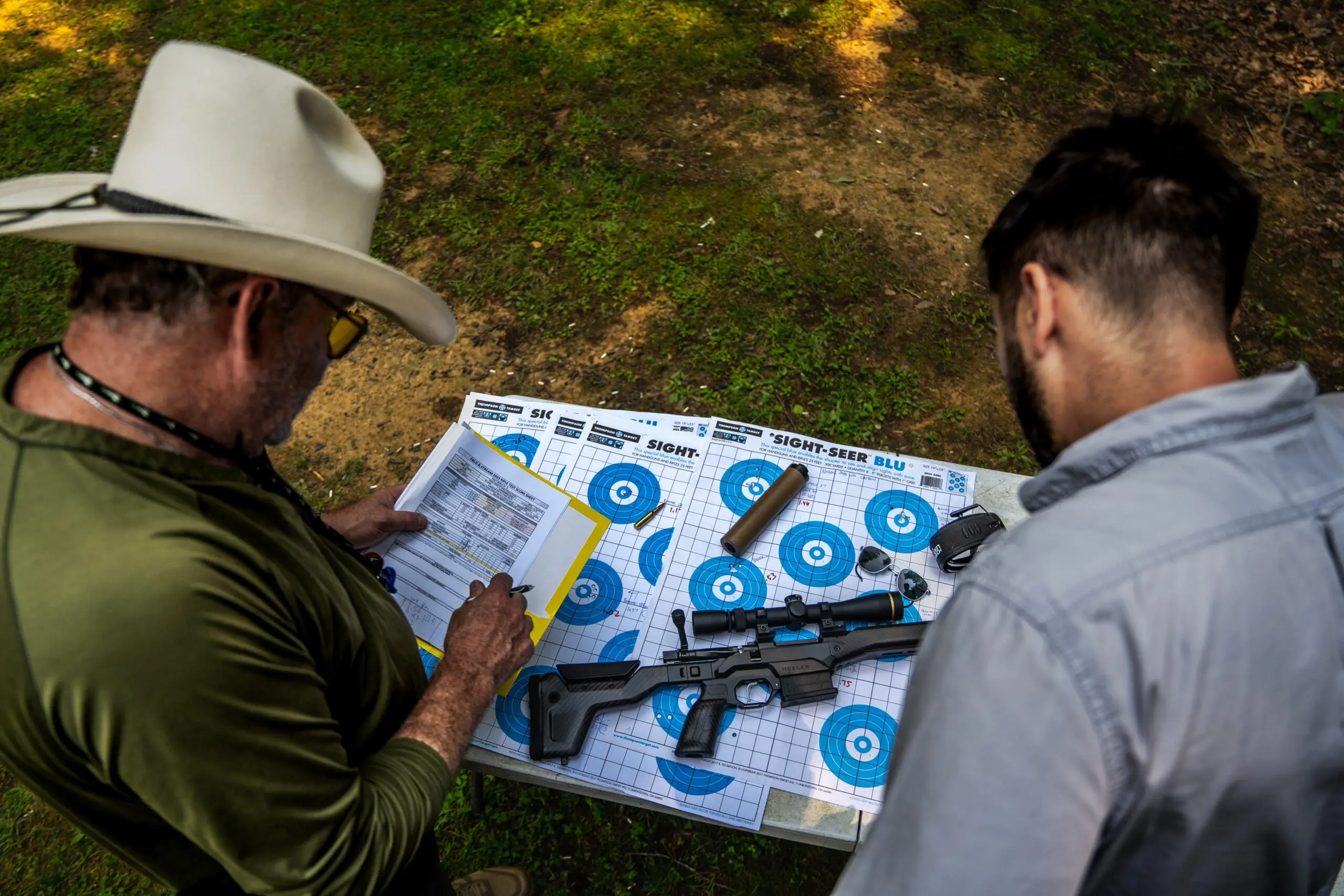
| We shot all the rifles for precision from a bench rest at 100 yards. After the shooting, we tallied the groups and averaged for scores. Sabastian “Bat” Mann |
We scored each rifle in five categories worth 20 points each. The rifles were not pitted against each other; they were evaluated individually, because there’s no way to reasonably compare a lever-action 44 Magnum to a bolt-action 6.5 Creedmoor. Also, each evaluator was allotted one extra “personal favorite” point to give to the rifle they thought most deserving. The evaluated categories included:
Shooting Precision (20 points): What size five-shot, 100-yard groups can the rifle be expected to deliver from the bench?
Shooter Interface (20 points): Was the stock comfortable, was it easy to interact with the trigger, was the action easy to operate, was the comb height correct, and how did the rifle carry and handle in the field?
Reliability (20 points): Did the rifle work? Did it feed reliably and function as intended? Were there any stoppages, failures, or quirks?
Workmanship (20 points): How was the stock-to-metal fit, were there visible tool marks? Was the finish consistent and attractive, and was the overall design consistent with the rifle’s intended purpose?
Price (20 points): Money always matters. But just because a rifle is cheap or expensive does not mean the price is good or bad. We evaluated each rifle for its overall value—that is, its bang for your bucks.
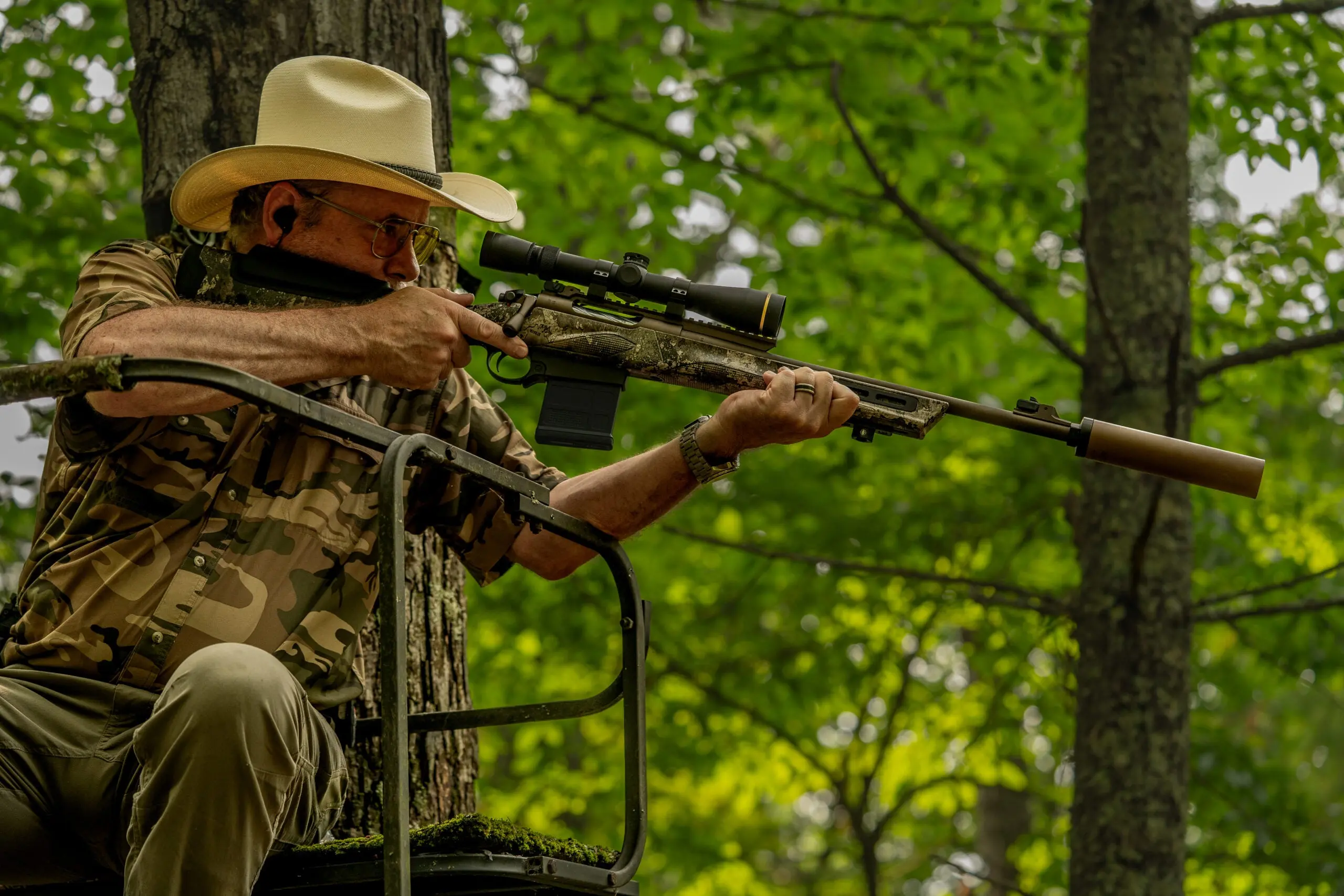
| Mann fires the Franchi Momentum All-Terrain Elite rifle from ladder stand. |
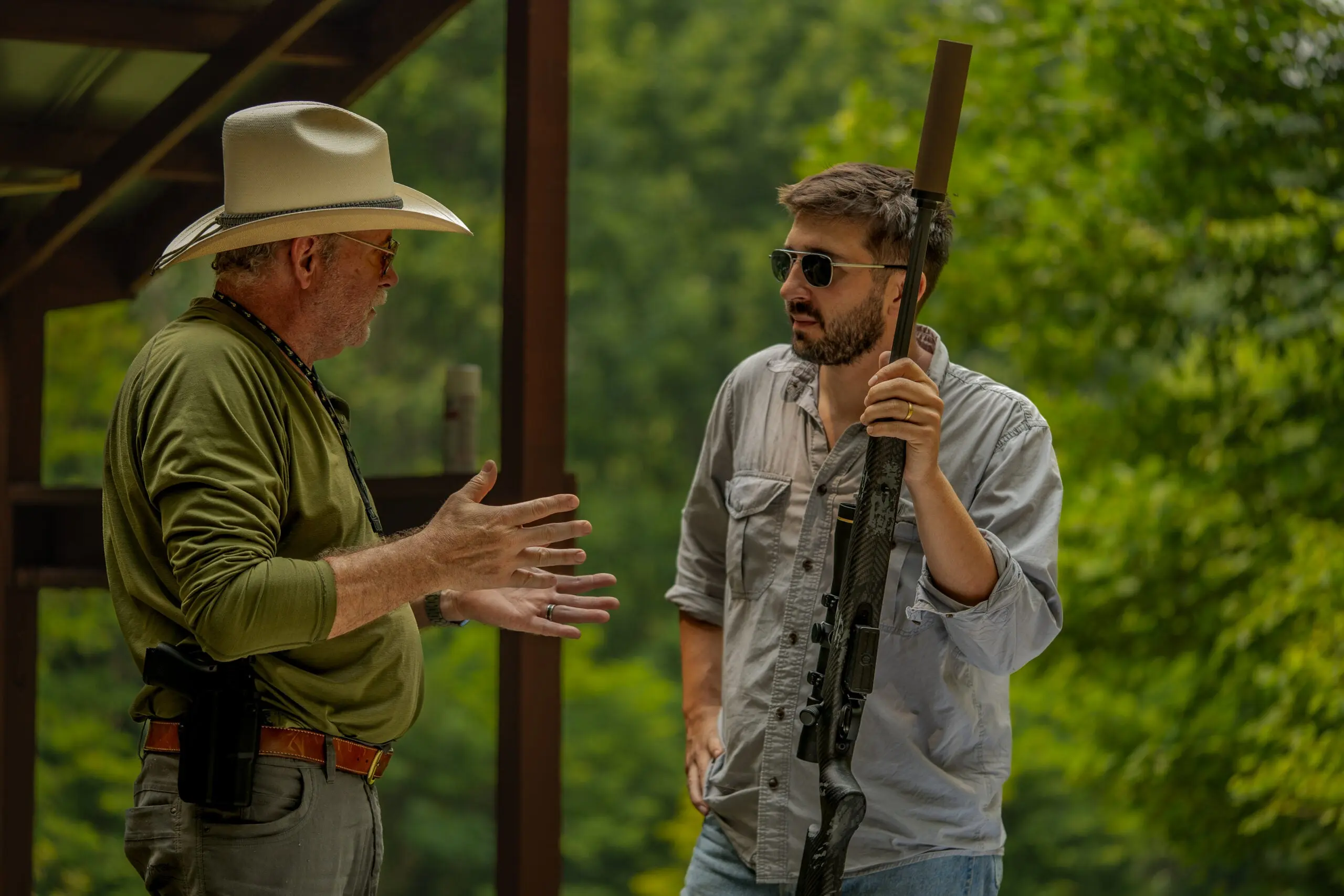
| Mann and Every discuss the features of the Bergara B14 Squared Crest. Sabastian “Bat” Mann |
Riflescopes, Accessories & Ammunition

You cannot test rifles without optics, ammunition, and targets. Every rifle in our test was outfitted with the excellent Leupold VX-3HD 4.5-14X40 CDS-ZL riflescope, and in most cases mounted in Leupold rings. Thompson Target provided all the targets for the precision testing and field shooting. Barnes, Browning, Buffalo Bore, Federal, Hornady, Remington, and Winchester, provided lots of ammunition in various bullet weights and styles.

![Field & Stream [dev]](https://images.ctfassets.net/fbkgl98xrr9f/1GnddAVcyeew2hQvUmrFpw/e4ca91baa53a1ecd66f76b1ef472932b/mob-logo.svg)





